Richard Risemberg
2009
Los Angeles: AKA seventy suburbs in search of a city, AKA La La Land, AKA the Ground Zero of Carmageddon. It is where sprawl was born and road rage made its name. The city itself covers nearly 500 square miles and is intertwined with dozens of smaller municipalities, from haughty Beverly Hills to pathetic corners of lost county land that rot away in the sun, forgotten and unmourned. Summer temperatures can run to 100℉ for weeks at a time, the brief winter rains can rival monsoons, and the banal vastnesses of its coastal plain are regularly cut by 2,000 foot tall mountain ranges. Earthquakes knock down bridges; fires scorch the land and the air; angry traffic rages along ten-lane streets that would be freeways any other place.
New York, Chicago, San Francisco, Paris, all have their songs...of LA, Dionne Warwick sang, in 1968:
"LA is a great big freeway.Is this where you would expect to find a thriving and remarkably civil urban cycling movement?
Put a hundred down and buy a car.
In a week, maybe two, they'll make you a star
Weeks turn into years, how quick they pass
And all the stars that never were
Are parking cars and pumping gas...."
Of course it's not. But, here it is.
A lot has changed since 1968....
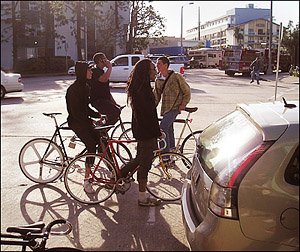
Fixie Kids, Venice Beach
Compare that to now, with the environmental movement vigorous, global warming staring us in the face, and the emptiness of suburban sprawl (for which Los Angeles was the model) leaving us hungry for community: a perfect synchronicity of both positive and negative factors working to re-animate urban cycling in the very city that once scorned it most. Add to that a retail culture that has apparently learned from past mistakes and is offering not only touring bikes again, but dedicated city bikes along the European model, ready-made fixies for slipping gracefully through traffic, and even cargo bikes and bakfietsen perched ready on the showroom floor, and you can see that Los Angeles, while no Amsterdam or even Portland, is poised to leap into the Bicycle Millennium with a loud and joyous "wheeee!"
So let's take a look at what's happening here in this beleaguered city, 70% of which is covered in asphalt to make room for all those cars. Is there room for cycling in it too?
Persistence Pays
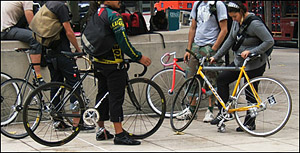
Bike Messengers, Downtown
While many people now feel that the emphasis on racing turned non-athletic types away from cycling during those aforementioned "dark ages," the fact remains that the racing clubs kept the bicycle in the public eye--and the civic consciousness--during a time when, for whatever reason, only sportifs and a few unrepetentant tree-huggers were doing much riding at all on LA's streets.
But what a blossoming of bicycle love we have witnessed in the last few years here!
Where only a few years ago bike culture was fairly dry and sparse here, now there are dozens of group rides to choose from nearly every week--starting, of course, with Critical Mass.
There are at least five CM rides in the Los Angeles area--LA being just so damned big! One in Mid-Wilshire, one in Northeast LA, and one in the San Fernando Valley, as well as out west in Santa Monica and back east in Pasadena--all part of the great sprawl we call Los Angeles. There are probably others that aren't listed online, and there's one or two that have faded away or merged with nearby rides over the years.
In some ways, the political necessity for Critical Mass has been fading as more and more people just get out and ride, for whatever reason--and fixie culture has provided a huge boost to bicycling's modal share in the transport mix here. CM has begun to evolve more towards a (slowly) rolling street party than an assertion of rights. In fact, many now feel that the aggressive posturing some riders engage in when massing has become politically counterproductive, and small and sporadic "Critical Manners" rides make an occasional appearance.
The Midnight Ridazz, on the other hand, make no bones about being out for fun, and the rides are scheduled late at night in part to minimize probabilities for confrontation. The Ridazz' website even stresses their cooperation with the Los Angeles Police Department (historically never a friend of any counterculture whatsoever), and the rides tend towards hilarious meanders, often somewhat alcoholic, across the varied landscapes of Los Angeles. MR was started only a few years ago by five friends, but with current rides drawing 1,500 to 2,000 riders, the ride has had to split into several entities to make room for all.
C.R.A.N.K. Mob and other spinoffs have also been taking up the slack, for there is a growing hunger for bicycle togetherness in this city, and these easy-paced, casual, and above all inclusive rides draw every sort of rider on every sort of bike.
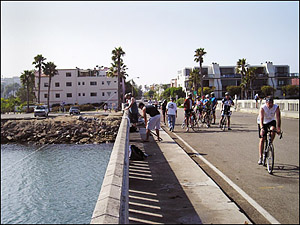
Bicycle Bridge, Playa del Rey
There are also architecture-themed rides and other sporadic mini-tours of LA on someone's schedule somewhere all year round.
Even the politicians get into the act, with councilmember Tom LaBonge often leading constituents on easy-paced rides of discovery in the varied neighborhoods of LA--continuing a practice his friend Richard Riordan established when he was mayor several terms back.
These rides, besides being pleasurable in themselves, are a boon to new riders finding their way for the first time through this vast and daunting city on a bicycle.
Reaching Out
The last ten years have been rich ones for bicycling outreach and advocacy in this city, and a quiet little intentional community, the LA Ecovillage, has been an outsized influence on the movement, almost as a side effect of its urban-sustainability program.
Joe
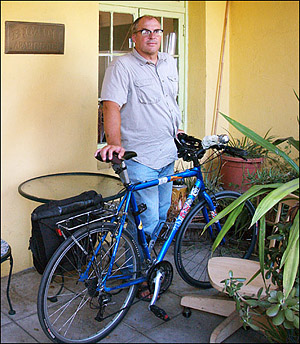
Joe Linton at the LA Ecovillage
Linton knew a lot of the "lone wolf" bicycle activists of the day--folks such as the late Dennis Crowley, who worked largely unassisted on projects such as the still-unrealized California Cycleway--and he felt there was a better way to promote cycling infrastructure and bike-friendly policies. When Chris Morfas of the California Bicycle Coalition suggested that LA was ripe for a local advocacy group, Linton and Milam jumped on it, publishing their first newsletter before even naming the nascent organization--which became today's tireless Los Angeles County Bicycle Coalition.
Although Linton frets that car culture still rules at the LA Department of Traffic, and that DOT treats is Bikeways Division as a dumping ground for staffers who don't drink the automotive Kool-Aid, there have been successes, mostly in the establishment of numerous bike lanes and paths--although they have been built in "dribs and drabs," and there is no true network yet.
Yet LACBC fights on (along with providing other services such as bike valet parking for events), and the new generation is fiercely committed to not only stripes and sharrows, but grand concepts such as "bicycle boulevards": streets where bicycles are through traffic but cars are restricted by tasteful impediments to local access only.
Linton is still an active activist, working now with Pasadena's C.I.C.L.E.org--whose initials stand for "Cyclists Inciting Change through Live Exchange." On his agenda: "road diets," a complete onstreet network of paths and lanes, and parking reform to free up space for cyclists and end the relentless civic subsidy of car use. Despite occasional discouragements, he soldiers on.
Then there's Jimmy Z.
Jimmy
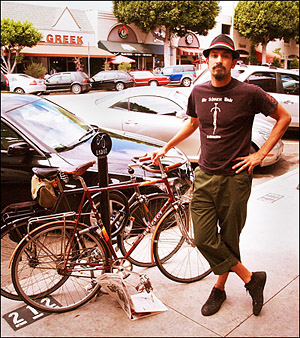
Jimmy Z
He now earns his living as a bike messenger, and devotes his free time to getting Angelenos onto bike seats, mostly through the famed Bicycle Kitchen.
The Bicycle Kitchen began in the Ecovillage when Jimmy asked if he could repair his bikes in an unused actual kitchen in the building. Friends began to hang out with him, and Ron Milam suggested he let he open his kitchen to other riders, not just Ecovillage residents. One thing led to another, and, in effect, the Bicycle Kitchen founded itself when a critical mass of cyclists began interacting as they worked on bikes.
It was an idea too good to keep to himself, so Jimmy made some flyers to give out at the LACBC's first Los Angeles River Ride. The Kitchen's success outpaced its resources, and within two years, the "cooks," as they call themselves, began looking for a storefront. They finally found one, at Heliotrope and Melrose in East Hollywood--and suddenly LA had a physical nexus for its burgeoning bike culture scene.
Now the corner boasts a full-service retail bike shop, Orange 20 Bikes, operated by two Kitchen volunteers and selling everything from fixies and BMX bikes to touring and city bikes and full-on Dutch cargo bicycles. You can get anything from top-tube pads to Brooks saddles there, and all are welcome, and made to feel welcome--anybody, any bike.
Next door to Orange 20 is what might be called an actual bicycle kitchen, Pure Luck, a former Korean restaurant transformed into a vegan pub owned and run by tattooed cyclists, and garnering excellent reviews from LA's puzzled food journalists. Across the street is Tai Kim's Scoops, selling artisanal gelati formulated every day by Otis Art Institute graduate Kim. The list changes daily, and there's a board where you can suggest flavors for him to make next week.
There's also, for the über hip, a tattoo parlor and a hookah bar--and for the young and ambitious, Los Angeles City College is on the same block. The corner has earned its own moniker, when Somerset (also living in the Ecovillage with his wife Aurisha, who now works for the LACBC) blurted out "Hel-Mel" when referring to it, and the name stuck. It's Hel-Mel to one and all, even non-cyclists reading the local weeklies, who have adopted the term.
The Kitchen is now a registered 501c(3) non-profit with an educational mission--one in which Jimmy Z participates with energetic pleasure. He's currently working on a manual for people wanting to start their own Kitchen, and hopes in the future to begin building bike frames for community riders--not ultra-expensive customs, but frames for working folks to ride for transport in their daily lives.
Meanwhile, the Kitchen has served as an inspiration to other neighborhoods (and other cities!): there are at least two local spinoffs, each now associated with a community-oriented bike shop: Bikerowave on the Westside, across the street from LA Brakeless, and the Bike Oven, two doors down from Josef Bray-Ali's shop, Flying Pigeon LA.
It is significant that Bray-Ali sells only transportation and cargo bikes at the shop. And, like Jim Cadenhead and TJ Flexer at Orange 20, who were "cooks" at the Bicycle Kitchen, he began as a volunteer at the Bike Oven, which he founded in emulation of the Kitchen.
Harv
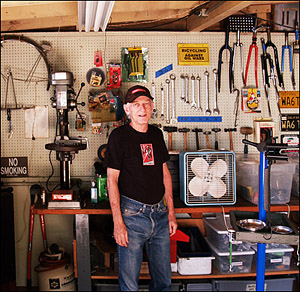
Harv at His Home Workshop
Woien's family moved to Los Angeles when he was twelve, and "as soon as the bike was off the moving van, I was all over this city," riding up Crenshaw to the model airplane shop, riding to the Aquarium Society, to school, everywhere, night and day. He rode his motorcycles more often through college, then returned to the bicycle afterwards, buying his first ten-speed in the late 'Sixties, just in time for the 'Seventies Bike Boom. His experience made him the local "expert" for his colleagues who became interested in bikes, and he founded the DWP Bicycle Club (he worked most of his life at the Department of Water and Power), leading rides along Mulholland Drive and Topanga Canyon, through Griffith Park, along the San Gabriel River, and all over the city.
Now retired, he is busier than ever with volunteer advocacy work, becoming involved over the years with Northeast LA Bikes and, through NELA, the Bike Oven, as well as CICLE.org in Pasadena, to whose website he is a frequent contributor. But the Bike Oven, just down the hill from his Montecito Heights home, is where he spends much of his time, helping with their various outreach and educational programs, which go beyond the neighborhood to providing food for the homeless, bicycles for downtown shelters, toy runs for special needs kids, and more. One of their more recent efforts provided a delivery bike for a South-Central LA food co-op--helping keep the neighborhood air clean all over LA.
One more point of light in LA's burgeoning bike scene!
Dorothy
At the other end of the age spectrum is 24-year-old Dorothy Kieu Le, two years out of UCLA with a degree in environmental sciences, who works as Planning and Policy Director for the Los Angeles County Bicycle Coalition founded by Joe Linton and Ron Milam when Le was barely past kindergarten.
She was born in Orange County but grew up in Manhattan Beach, a charming beachside town with plenty of cycling, including a USCF race every year. Although a former boyfriend nagged her into getting a car, claiming she "couldn't appear mature" without one, she rarely drives it, preferring her bike, of course, or LA's quickly-improving Metro system. Her second year at UCLA brought her back into the cycling fold, when she chanced upon the Santa Monica Critical Mass ride.
Pedaling in CM got her to see how easy it was to ride the streets, and she realized that "if I could do it in a group, I could do it alone." That led her, perhaps inevitably, into on-campus bicycle advocacy and eventually into the position at LACBC.
Her first project at the Coalition was in support of better cyclist and pedestrian access to Metro stations, followed by work on the local "Safe Routes to School" program (necessary in a city where parents may drive their children three blocks to class). Her big push now is to get funds from Measure R, a tiny boost in the local sales tax dedicated to "traffic relief and transportation upgrades," allocated to bicycle projects. LACBC feels, quite rightly, that a sliver of the $40 billion to be allocated would go a long way towards providing attractive and effective bicycle infrastructure to the cities of LA County.
Coordination of bike infrastructure planning among LA County's 88 separate municipalities is another part of Le's job at the Coalition.
Another important LACBC function in which Le is involved is "City of Lights", an outreach program in English and Spanish trying to help the area's vast number of Latino cyclists upgrade their bikes to street safety standards, primarily through providing lights for night and early-morning riding, as well as brochures and workshops in safe riding. Thanks in part to LACBC's attentions, traffic deaths of cycling immigrant workers are no longer routinely ignored by the LAPD, and the riders themselves are being drawn in to LA's cycling community, and hence into LA as a whole.
That's the recent past. What Le hopes to see in the near future includes the "road diets" Joe Linton also spoke of: the reallocation of space from land-hogging cars to pedestrians and, of course, cyclists, as well as an expansion of LA's city council and county board of supervisors to ensure that neighborhoods have more say in what happens to them.
Farther down the timeline? More continuous bike corridors throughout the city, so that bike lanes don't simply disappear at a city limit or a T-intersection, as they often do now.
It's not easy--everything LACBC does here is struggle--Le says, but with help from LA's cyclists, be it in money or in volunteer work, they will get it done.
James & Pedro
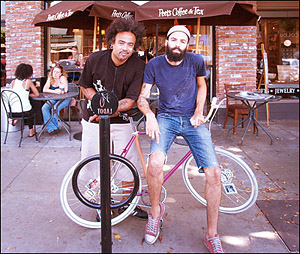
Pedro and James
After 300 years of racism, Black folk need a "place to relax, a 'safe space'" where they can be themselves, and Spooner, remembering the intense feeling of freedom of his own first bike ride, wanted cycling to be one of those safe spaces.
The idea catalyzed when he was riding along Melrose Avenue in Hollywood and met Toons, one of the Black owners of Bikestyler Customs; in their talk the idea came up of staging an all-Black bike ride. Spooner started "Black Kids on Bikes"--which is not limited to kids or Black folk--and began organizing the "Freedom Rides" under its aegis.
As Balugo says, the "Kids" refers to their feeling "kind of like unsupervised grown-up teenagers," but the rides tend to be mannerly (especially compared to Critical Masses) and oriented to community-building among participants. Balugo heard of the Freedom Ride through Afro-Punk, but was leery of joining in as he had a white girlfriend at the time. He asked Spooner if he could bring her, and the answer was, "Why would it matter?" Balugo adds, "There's no hidden agenda; we're just out to ride and have fun. It's a bike ride--simple as that." Anyone who shows up can ride.
And the important thing is that many of those who do show up haven't been on a bike for fifteen years or more. In fact, Spooner, who also assembles bikes to sell to folks who need inexpensive transportation, keeps a couple of "invitation bikes" that curious but wheel-less riders can borrow. So far, every rider who has borrowed one has ended up buying their own bike, and two of them are now riding to work every day!
Spooner and Balugo feel that that translates into real freedom--the ability to go across town unrestrained by the expenses of a car, to work, to meet friends, and to find new experiences.
But of course there's always the pull of athleticism, so the pair has started another ride, their answer to the Wolfpack Hustle--a fast-paced midnight ride called "Zulu Dawn." Fast-paced--but still no spandex! They'll always be punk-rockers at heart, and that's how they roll.
Michelle
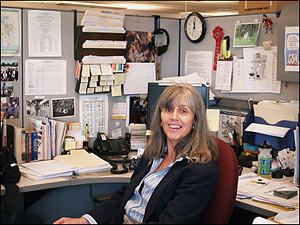
Michelle at Work
Mowery, who has held the position since 1994, has managed to get a good bit of bicycle infrastructure on the ground in the last fifteen years, despite being immersed in the bureaucratic intricacies suggested by the verbiage on her business card. Over the years, she has come to realize that a "huge part of my job is talking to people who always say 'No,' till they finally say 'Yes'" to bicycle projects. But it isn't easy--LA, though less so now, is still a "great big freeway," much to its regret, and it's hard to overcome decades of inertia in the city that invented and refined "Car Culture" and its attendant sprawl.
Still, there have been successes: when Mowery began at DOT, there were no public bikes racks in Los Angeles; now there are 3500 of them, with more going in weekly--and other local cities are following suit. Mowery also began working on parking meter retrofits ten years ago--a hard pull back then, especially as it's technically illegal to park a bike on a meter in LA. But now that traditional parking meters are being phased out in favor of paystations, Mowery has persuaded DOT not to uproot all the old meters, but to slip a lock-on adapter over them that converts them to bike racks--complete with DOT logo and a little silhouette of a bike!
It was tough going, since it's still illegal to park a bike on a meter--but a collective epiphany brought DOT to realize that a meter pole without the meter head is no longer a parking meter. Although at present it's still a pilot program, this promises to bring about a significant increase in bike parking throughout LA as traditional meters continue to be phased out for paystations.
DOT will also install standard inverted-U bike racks for free outside businesses that request them; otherwise they try to distribute racks evenly throughout the city, so many to each council district according to population.

Bike Parking in the Caltrans Building
The new Bicycle Master Plan for Los Angeles, while far from ideal from many a daily rider's point of view, strives to establish a comprehensive network of "bike friendly streets," some of which may eventually become full-fledged bicycle boulevards, with through car traffic filtered out. This is what she sees as the most important part of her work for the next ten years--a job complicated by the fact that the City of Los Angeles comprises only 39% of Los Angeles County, and that the mishmash of 88 cities that forms the Greater Los Angeles Area--from Beverly Hills, Santa Monica, and West Hollywood to Maywood, Compton, Vernon, and Industry--means facilities will often, in fact, disappear at an invisible line in the street, as you roll from one city to another, or into unincorporated territory.
There are victories. Now, when the DOT counts traffic, it counts cyclists and pedestrians as well as cars. The new Expo light rail line will have a bike path along its entire length, as does the Orange Line busway in the Valley. Metro has made more room for bikes on its Red and Purple Line trains. Road diets are being considered seriously for the first time.
There is, of course, much to be done: Mowery in particular is trying to establish more bike lanes on arterial streets--the ones that get you to work the fastest. And too many facilities on the new bikeways map are marked "proposed but currently infeasible"--and we can all guess what that really means.
But with the help of individual citizen activists and local NGOs, especially the LACBC, it looks like we're finally getting someplace after a long dry season.
LA Today
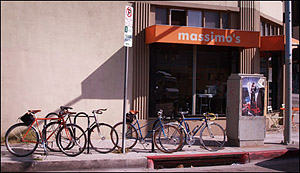
Morning Coffee, Miracle Mile
I haven't heard that question since, I think, around the year 2000. More often now I get a thumbs-up and shouts of approbation. More people are riding, more shops are offering practical bikes along with carbon road racers and downhill mountain bikes. Drivers are politer, and sometimes even deferential. Even people who don't ride yet understand and generally approve. And government is slowly catching up to the realities on the street, as well as the realities of sprawl, global warming, the public health burdens of sedentary lifestyles, and the myriad of other social and physical ills that active transportation, including bicycling, can forestall.
It's not a cycling paradise yet, by any means, but it's becoming a place where it's not only possible to ride—because it's always possible—but it's pleasurable as well.
At long last, Los Angeles is becoming a place where bicyclists can feel at home.
Text and Photos by Richard Risemberg
Hal David, lyrics, "Do You Know the Way to San Jose?"
CommunityLos Angeles County Bicycle Coalition (LACBC)
Rides
Velo-Retro Rose Bowl Vintage Ride
Shops
There is so much more we had to leave out....

